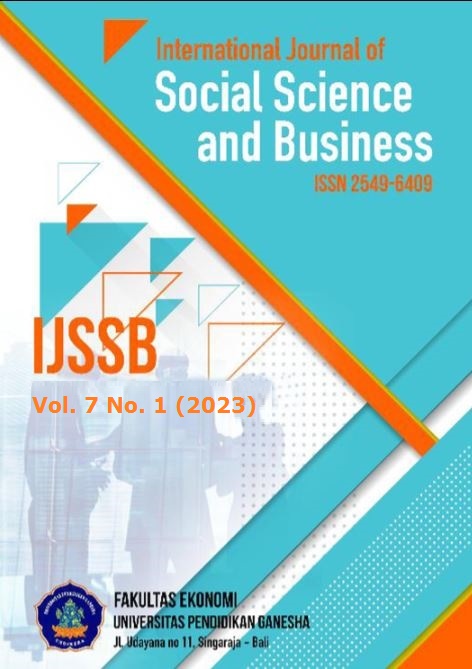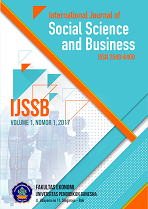Fostering Readiness to Change through Work Engagement in Indonesian Government Organization
DOI:
https://doi.org/10.23887/ijssb.v7i1.48032Keywords:
Readiness to Change, Work Engagement, Goverment OrganizationAbstract
Organizational change has been widely examined by scholars. A readiness to change is essential to attain a success of the organizational change. Previous studies on readiness to change supported by employee’s engagement in government context are scarcity. Thus, this study aims to examine the relationship between the readiness to change and the employee’s engagement in religious affairs institution context. This study also investigates the relationship of those variables moderated by generation X and Y. The quantitative approach with survey research design was undertaken by administering a questionnaire to 179 civil servants under religious affairs institution online. The data was analyzed using PLS-SEM. The findings suggested that the employee’s work engagement and the process of change had a positive and significant relationship to the readiness to change. The work engagement had positive and significant relationship to the process of change and trust in the leadership. The trust in the leadership had positive and significant relationship to the process of change; however it did not have a relationship to the readiness to change. Moreover, generation X and Y did not moderate the relationship the work engagement and the readiness to change as well the process of change. The theoretical and managerial implications are discussed further.
References
Agote, L., Aramburu, N., & Lines, R. (2016). Authentic leadership perception, trust in the leader, and followers’ emotions in organizational change processes. The Journal of Applied Behavioral Science, 52(1), 35–63. https://doi.org/10.1177/0021886315617531. DOI: https://doi.org/10.1177/0021886315617531
Altayar, M. S. (2018). Motivations for open data adoption: An institutional theory perspective. Government Information Quarterly, 35(4), 633–643. https://doi.org/10.1016/j.giq.2018.09.006. DOI: https://doi.org/10.1016/j.giq.2018.09.006
Amis, J. M., & Aïssaoui, R. (2013). Readiness for change: An institutional perspective. Journal of Change Management, 13(1), 69–95. https://doi.org/10.1080/14697017.2013.768435. DOI: https://doi.org/10.1080/14697017.2013.768435
Asquer, A. (2013). Managing challenging organizational change: Introducing active labour market policies in Italian public employment agencies. Public Management Review, 17(6), 901–921. https://doi.org/10.1080/14719037.2013.868506. DOI: https://doi.org/10.1080/14719037.2013.868506
Bedarkar, M., & Pandita, D. (2014). A study on the drivers of employee engagement impacting employee performance. Procedia-Social and Behavioral Sciences, 133, 106–115. https://doi.org/10.1016/j.sbspro.2014.04.174. DOI: https://doi.org/10.1016/j.sbspro.2014.04.174
Bellou, V., & Chatzinikou, I. (2015). Preventing employee burnout during episodic organizational changes. Journal of Organizational Change Management, 28(5), 673–688. https://doi.org/10.1108/JOCM-11-2014-0197. DOI: https://doi.org/10.1108/JOCM-11-2014-0197
Bertoldi, B., Giachino, C., Rossotto, C., & Bitbol-Saba, N. (2018). The role of a knowledge leader in a changing organizational environment. A conceptual framework drawn by an analysis of four large companies. Journal of Knowledge Management, 22(3), 587–602. https://doi.org/10.1108/JKM-09-2017-0422. DOI: https://doi.org/10.1108/JKM-09-2017-0422
Boohene, R., & Williams, A. A. (2012). Resistance to organisational change: A case study of Oti Yeboah Complex Limited. International Business and Management, 4(1), 135–145. https://doi.org/10.3968/j.ibm.1923842820120401.1040.
Bouckenooghe, D., Devos, G., & Van Den Broeck, H. (2009). Organizational change questionnaire–climate of change, processes, and readiness: Development of a new instrument. The Journal of Psychology, 143(6), 559–599. https://doi.org/10.1080/00223980903218216. DOI: https://doi.org/10.1080/00223980903218216
Chin, W. (1998). The partial least squares approach to structural equation modeling. Modern Methods for Business Research, 295(2), 295–336. https://doi.org/10.1016/j.aap.2008.12.010. DOI: https://doi.org/10.1016/j.aap.2008.12.010
Costello, J. E., & Arghode, V. (2020). Exploring member readiness for change in manufacturing industries using phenomenology. Management Research Review, 43(7), 847–861. https://doi.org/10.1108/MRR-05-2019-0214. DOI: https://doi.org/10.1108/MRR-05-2019-0214
Diab, G. M., Safan, S. M., & Bakeer, H. M. (2018). Organizational change readiness and manager’ behavior in managing change. Journal of Nursing Education and Practice, 8(7), 68–77. https://doi.org/10.5430/jnep.v8n7p68. DOI: https://doi.org/10.5430/jnep.v8n7p68
Douglas, S., & Roberts, R. (2020). Employee age and the impact on work engagement. Strategic HR Review, 19(5), 209–213. https://doi.org/10.1108/SHR-05-2020-0049. DOI: https://doi.org/10.1108/SHR-05-2020-0049
Erkutlu, H., & Chafra, J. (2016). Value congruence and commitment to change in healthcare organizations. Journal of Advances in Management Research, 13(3), 316–333. https://doi.org/10.1108/JAMR-11-2015-0078. DOI: https://doi.org/10.1108/JAMR-11-2015-0078
Fornell, C., & Larcker, D. F. (1981). Evaluating structural equation models with unobservable variables and measurement error. Journal of Marketing Research, 18(1), 39–50. https://doi.org/10.1177/002224378101800104. DOI: https://doi.org/10.1177/002224378101800104
Gatenby, M., Rees, C., Truss, C., Alfes, K., & Soane, E. (2015). Managing change, or changing managers? The role of middle managers in UK public service reform. Public Management Review, 17(8), 1124–1145. https://doi.org/10.1080/14719037.2014.895028. DOI: https://doi.org/10.1080/14719037.2014.895028
Hair, J. F., Risher, J. J., Sarstedt, M., & Ringle, C. M. (2019). When to use and how to report the results of PLS-SEM. European Business Review, 31(1), 2–24. https://doi.org/10.1108/EBR-11-2018-0203. DOI: https://doi.org/10.1108/EBR-11-2018-0203
Håvold, O. K. S., Håvold, J. I., & Glavee-Geo, R. (2021). Trust in leaders, work satisfaction and work engagement in public hospitals. International Journal of Public Leadership, 17(2), 145–159. https://doi.org/10.1108/IJPL-07-2020-0061. DOI: https://doi.org/10.1108/IJPL-07-2020-0061
Hussain, S. T., Lei, S., Akram, T., Haider, M. J., Hussain, S. H., & Ali, M. (2018). Kurt Lewin’s change model: A critical review of the role of leadership and employee involvement in organizational change. Journal of Innovation & Knowledge, 3(3), 123–127. https://doi.org/10.1016/j.jik.2016.07.002. DOI: https://doi.org/10.1016/j.jik.2016.07.002
Iqbal, A., & Asrar-ul-Haq, M. (2018). Establishing relationship between TQM practices and employee performance: The mediating role of change readiness. International Journal of Production Economics, 203, 62–68. https://doi.org/10.1016/j.ijpe.2018.05.034. DOI: https://doi.org/10.1016/j.ijpe.2018.05.034
Ismail, D. H., Asmawi, M., & Widodo, S. E. (2020). The effect of organizational culture, leadership style, and trust to organizational commitments of LP3I Polytechnic Jakarta lectures. IJHCM (International Journal of Human Capital Management), 4(1), 16–25. https://doi.org/10.21009/IJHCM.04.01.02. DOI: https://doi.org/10.21009/IJHCM.04.01.02
Knight, C., Patterson, M., Dawson, J., & Brown, J. (2017). Building and sustaining work engagement–a participatory action intervention to increase work engagement in nursing staff. European Journal of Work and Organizational Psychology, 26(5), 634–649. https://doi.org/10.1080/1359432X.2017.1336999. DOI: https://doi.org/10.1080/1359432X.2017.1336999
Kock, N. (2017). Which is the best way to measure job performance: self-perceptions or official supervisor evaluations? International Journal of E-Collaboration (Ijec), 13(2), 1–9. https://doi.org/10.4018/IJeC.2017040101. DOI: https://doi.org/10.4018/IJeC.2017040101
Lauricella, T. K., Ford, J. K., Riley, S. J., Powers, C. L., & Lederle, P. (2017). Employee perceptions regarding an organizational change initiative in a state wildlife agency. Human Dimensions of Wildlife, 22(5), 422–437. https://doi.org/10.1080/10871209.2017.1342013. DOI: https://doi.org/10.1080/10871209.2017.1342013
Lee, J. (2011). Aligning organizations for positive change: The role of leadership in matching strategy, culture, and social networks to vital organizational challenges. Advances in Global Leadership, 6, 71–94. https://doi.org/10.1108/S1535-1203(2011)0000006007. DOI: https://doi.org/10.1108/S1535-1203(2011)0000006007
Ludviga, I., & Sennikova, I. (2016). Organisational change: generational differences in reaction and commitment. 9th International Scientific Conference of Business and Management, Vilnius, Lithuania. https://doi.org/10.3846/bm.2016.10. DOI: https://doi.org/10.3846/bm.2016.10
Malik, P., & Garg, P. (2020). Learning organization and work engagement: The mediating role of employee resilience. The International Journal of Human Resource Management, 31(8), 1071–1094. https://doi.org/10.1080/09585192.2017.1396549. DOI: https://doi.org/10.1080/09585192.2017.1396549
Mangundjaya, W. L., Utoyo, D. B., & Wulandari, P. (2015). The role of leadership and employee’s condition on reaction to organizational change. Procedia-Social and Behavioral Sciences, 172, 471–478. https://doi.org/10.1016/j.sbspro.2015.01.385. DOI: https://doi.org/10.1016/j.sbspro.2015.01.385
Mathews, B., & Linski, C. M. (2016). Shifting the paradigm: reevaluating resistance to organizational change. Journal of Organizational Change Management, 29(6), 963–972. https://doi.org/10.1108/JOCM-03-2016-0058. DOI: https://doi.org/10.1108/JOCM-03-2016-0058
Matos Marques Simoes, P., & Esposito, M. (2014). Improving change management: How communication nature influences resistance to change. Journal of Management Development, 33(4), 324–341. https://doi.org/10.1108/JMD-05-2012-0058. DOI: https://doi.org/10.1108/JMD-05-2012-0058
Matthysen, M., & Harris, C. (2018). The relationship between readiness to change and work engagement: A case study in an accounting firm undergoing change. SA Journal of Human Resource Management, 16. https://doi.org/10.4102/sajhrm.v16i0.855. DOI: https://doi.org/10.4102/sajhrm.v16i0.855
McKay, K., Kuntz, J. R., & Näswall, K. (2013). The effect of affective commitment, communication and participation on resistance to change: The role of change readiness. New Zealand Journal of Psychology, 42(2), 29–40. https://www.psychology.org.nz/journal-archive/Kuntz1.pdf.
Nurhidayah, D., & Wahyanti, C. T. (2021). Cyberloafing: Minimalizing work stress on millennial generations employee. International Journal of Social Science and Business, 5(3), 384–391. https://doi.org/10.23887/ijssb.v5i3.36872. DOI: https://doi.org/10.23887/ijssb.v5i3.36872
Petrou, P., Demerouti, E., & Schaufeli, W. B. (2018). Crafting the change: The role of employee job crafting behaviors for successful organizational change. Journal of Management, 44(5), 1766–1792. https://doi.org/10.1177/0149206315624961. DOI: https://doi.org/10.1177/0149206315624961
Purwanto, A., Purba, J. T., Bernarto, I., & Sijabat, R. (2021). Effect of transformational leadership, job satisfaction, and organizational commitments on organizational citizenship behavior. Inovbiz: Jurnal Inovasi Bisnis, 9(1), 61–69. https://doi.org/10.1080/00223980903218216. DOI: https://doi.org/10.35314/inovbiz.v9i1.1801
Rani, K., Rani, A., Sharma, P., Dahiya, A., Punia, H., Kumar, S., Sheoran, S., & Banerjee, A. (2022). Legumes for agroecosystem services and sustainability. In Advances in Legumes for Sustainable Intensification (pp. 363–380). Academic Press. DOI: https://doi.org/10.1016/B978-0-323-85797-0.00008-2
Rasyid, N., Burhan, H., & Mandiangan, P. (2018). The effect of organizational characteristics and environmental changes on the creation of rntrepreneurship foundation through individual characteristics variable (Case study on Smes in Palembang city). International Journal of Social Science and Business, 2(2), 82–92. https://doi.org/10.23887/ijssb.v2i2.13019. DOI: https://doi.org/10.23887/ijssb.v2i2.13019
Schaufeli, W. B., Bakker, A. B., & Salanova, M. (2006). The measurement of work engagement with a short questionnaire: A cross-national study. Educational and Psychological Measurement, 66(4), 701–716. https://doi.org/https://doi.org/10.1177/00131 64405282471. DOI: https://doi.org/10.1177/0013164405282471
Statnickė, G., Savanevičienė, A., & Šakys, I. (2019). The relationship between work engagement of different generations and mobile learning. Acta Universitatis Agriculturae et Silviculturae Mendelianae Brunensis, 67(6), 1627–1642. https://doi.org/10.11118/actaun201967061627. DOI: https://doi.org/10.11118/actaun201967061627
Stevens, G. W. (2013). Toward a process-based approach of conceptualizing change readiness. The Journal of Applied Behavioral Science, 49(3), 333–360. https://doi.org/10.1177/0021886313475479. DOI: https://doi.org/10.1177/0021886313475479
Stouten, J., Rousseau, D. M., & De Cremer, D. (2016). The relationship between readiness to change and work engagement: A case study within an accounting firm undergoing change. Academy of Management Annals, 12(2), 752–788. https://doi.org/10.5465/annals.2016.0095. DOI: https://doi.org/10.5465/annals.2016.0095
Sulistyawati, U. S., & Sufriadi, D. (2020). Perceived organization support towards employee engagement and the impact of employee job satisfaction. International Journal of Social Science and Business, 4(4), 513–519. https://doi.org/10.23887/ijssb.v4i4.28587. DOI: https://doi.org/10.23887/ijssb.v4i4.28587
Suwaryo, J., Daryanto, H. K., & Maulana, A. (2016). Organizational culture change and its effect on change readiness through organizational commitment. BISNIS & BIROKRASI: Jurnal Ilmu Administrasi Dan Organisasi, 22(1), 6. https://doi.org/10.20476/jbb.v22i1.5431. DOI: https://doi.org/10.20476/jbb.v22i1.5431
Vakola, M. (2013). Multilevel readiness to organizational change: A conceptual approach. Journal of Change Management, 13(10), 37–41. https://doi.org/10.1080/14697017.2013.768436. DOI: https://doi.org/10.1080/14697017.2013.768436
Van den Heuvel, M., Demerouti, E., Bakker, A. B., Hetland, J., & Schaufeli, W. B. (2020). How do employees adapt to organizational change? The role of meaning-making and work engagement. The Spanish Journal of Psychology, 23, E56. https://doi.org/10.1017/SJP.2020.55. DOI: https://doi.org/10.1017/SJP.2020.55
Williams, B., Onsman, A., & Brown, T. (2010). Exploratory factor analysis: A five-step guide for novices. Australasian Journal of Paramedicine, 8, 1–13. https://doi.org/10.33151/ajp.8.3.93. DOI: https://doi.org/10.33151/ajp.8.3.93
Yousef, D. A. (2017). Organizational commitment, job satisfaction and attitudes toward organizational change: A study in the local government. International Journal of Public Administration, 40(1), 77–88. https://doi.org/10.1080/01900692.2015.1072217. DOI: https://doi.org/10.1080/01900692.2015.1072217
Yu, J., Yuan, L., Han, G., Li, H., & Li, P. (2022). A Study of the Impact of Strategic Human Resource Management on Organizational Resilience. Behavioral Sciences, 12(12), 508. https://doi.org/10.3390/bs12120508. DOI: https://doi.org/10.3390/bs12120508
Zayim, M., & Kondakci, Y. (2015). An exploration of the relationship between readiness for change and organizational trust in Turkish public schools. Educational Management Administration & Leadership, 43(4), 610–625. https://doi.org/10.1177/1741143214523009. DOI: https://doi.org/10.1177/1741143214523009
Zhang, T., Avery, G. C., Bergsteiner, H., & More, E. (2014). The relationship between leadership paradigms and employee engagement. Journal of Global Responsibility, 5(1), 4–21. https://doi.org/10.1108/JGR-02-2014-0006. DOI: https://doi.org/10.1108/JGR-02-2014-0006
Downloads
Published
How to Cite
Issue
Section
License
Copyright (c) 2022 I Made Bayu Andika, Rina Anindita

This work is licensed under a Creative Commons Attribution-ShareAlike 4.0 International License.











